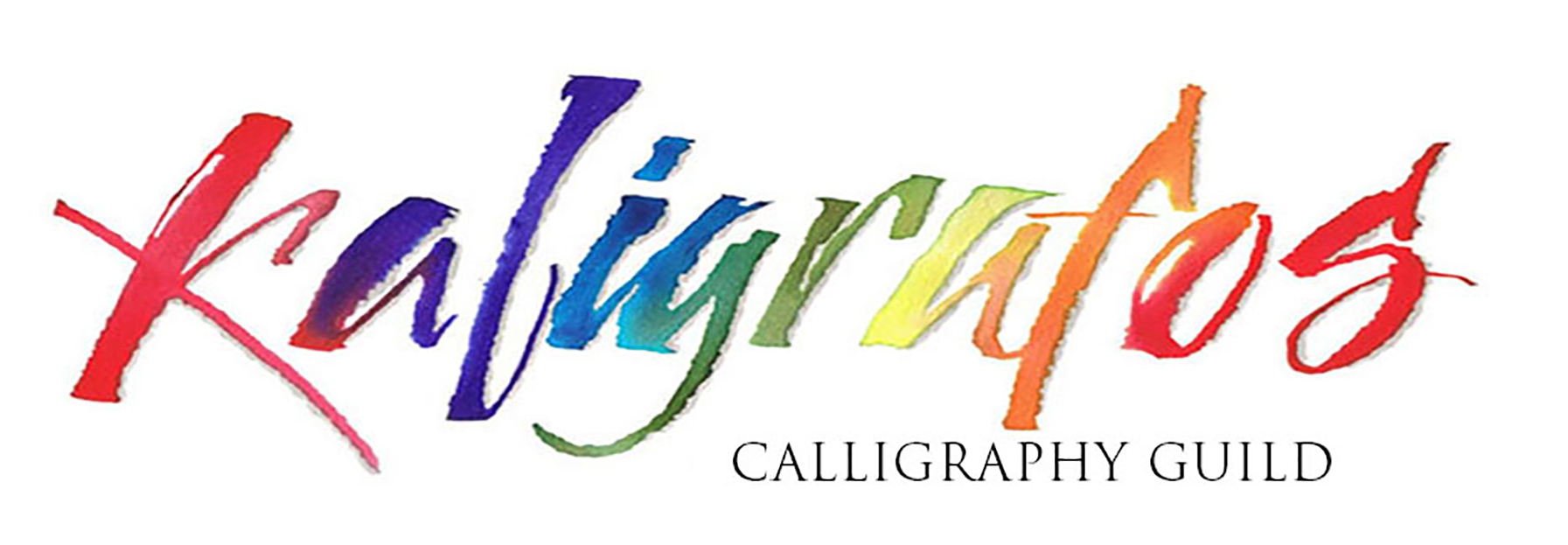A Review by Monica Winters
The members of Kaligrafos who braved the snowy and blustery elements to attend the January meeting – and there were surprisingly quite of few of us determined souls – were rewarded with the chance to observe a “Dance with the Star” of a new and innovative calligraphic style aptly demonstrated by our knowledgeable and energetic Thomas Burns.
This author was relieved to know that no singing was involved (Carrioka soundslike karaoke)!
“Carrioka” is a calligraphic hand style designed by Carrie Imai, calligrapher and author of the book Dancing Pen. The form’s style is chunky, much like the thick and heavy Neuland, but don’t be fooled into thinking that broad and heavy is simple to recreate. “Carrioka” dances on the page, boldly and seductively, requiring a bit of stretching, bending, twisting and toe-pointing, with a dramatic dip here and there.
After taking a workshop from the calligrapher/author in which she taught the way to formulate letters by manipulating the pen, Tom expertly demonstrated the process for his audience, emphasizing the skill required to hold and turn and twist the pen to create the forms, much like “dancing” with the pen across the surface of the paper. He emphasized that the pen must be perpendicular to the paper surface; and the arm cannot float but must rest against the surface to ensure strength and sureness of strokes. He further explained that as this hand is bold and broad, it is most suitable for emphasis in overall design, but it would be worth experimenting a full written page in the hand to test its readability in bulk. He also assured us that he received permission from his presenter to give instruction on the style.
Tom presented the participants (with his lovely sidekick Brenda) with an exemplar written in Walnut ink to show the overlaps that occur in the “dancing” strokes. There are two version of the alphabets: one bold and chunky, and the other lightened a bit with the use of curlicue-like details. An exercise in design consideration would be to combine the two styles (which Tom demonstrated later making door prizes by writing each winner’s names on placards, which were folded cards with a watercolor flower cutout extending beyond the top of the fold.).
Your partner in this dance, Tom went on, would be to have a pen that writes on its corner, such as a parallel pen, to be able to create the curlicue-like lines without having to stop and change pens (destroying the continuity of movement). There are no straight lines in this alphabet, and the rehearsal requires the cushioning of a pad of paper underneath to ease the movements. Tom additionally cautioned us against “white-knuckling” the dance. Yes, it feels awkward at first, but isn’t anything truly innovative worth the effort to learn the steps?
Tom peppered his performance with occasional general tips for his fellow calligraphers and wannabe scribes: A Craftmat, available at Hobby Lobby, which has a slick and non-absorbent surface, works well for spreading or splattering ink or watercolor and then to press (much like a monoprint) a sheet of paper on the wet mat to create abstract colorations or splatters for a background. The beauty of the Craftmat is (besides being inexpensive} that it can be rolled up (unlike a piece of glass) and cleaned. Also, at his new job at Madness, Games and Comics, Tom discovered “Underwear for Your Hands”, an open-fingered glove to protect your surface while writing, complete with elastic and flaps like men’s briefs. Something to lighten the load of a long day of calligraphing. Looking forward to March, when we can learn Weaver writing. Tom showed us an envelope he created utilizing and combining the styles of Carrioka and Weaver writing. Skillfully designed and executed, of course, to tantalize us.




Leave a Reply
Your email is safe with us.